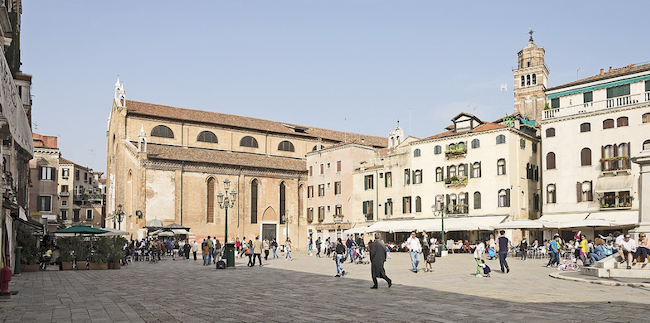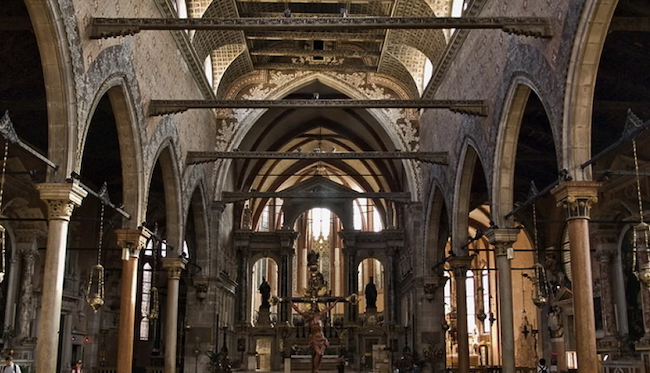Santo Stefano church in Venice is a jewel of Gothic architecture nestled in the historic heart of Italy. Visitors come here to admire its bold façade and remarkable works of art, including works by Tintoretto.

This church, founded in the 13th century by the Augustinian order, embodies a significant part of Venetian history, where art and faith meet in harmony. Initially conceived as a place of worship, Santo Stefano has over time become an essential stop-off point for understanding the city's history. the city's architectural and artistic evolution.
Key points
- Santo Stefano in Venice is a church renowned for its Gothic architecture and historic works of art.
- Founded in the 13th century by the Augustinians, it is an expression of Venetian history and culture.
- Local experts from Bonjour Venise offer informative guided tours of this iconic church.
Architecture and History
Venice's Santo Stefano church is a magnificent example of Gothic architecture in Venice. This section explores the Gothic influence, notable contributions, and landmark developments and restorations to the church.
Gothic influence
The Santo Stefano church is an emblem of Gothic art in Venice, with a Gothic portal built between 1438 and 1442 and attributed to the famous architect Bartolomeo Bon.
Its structure features a single nave with a roof in the shape of a ship's rumpThe design is typical of the Venetian Gothic style.
Notable contributions
Antonio Canovaa famous sculptor, is buried here, marking the church with his posthumous fame. The campanile, older than the current building, contains a three-arched chamber topped by an octagonal drum. Tullio Lombardo and Pietro Lombardo also contributed their expertise to the ornamentation and finishing of certain parts of the building.
Developments and Restorations
Over the centuries, the church has benefited from numerous restorations to maintain its structure and artistry, with notable additions such as the marble pulpits.
Extensive restoration work was carried out following damage suffered during the Doge's era. Francesco Morosini. Le Campo Santo Stefanowhere the church is located, completes the historical and cultural picture of this Venetian area.

Art and Cultural Significance
Venice's Santo Stefano church is distinguished by its rich artistic heritage and undeniable cultural and social importance. Our team of local experts reveals the treasures it houses.
Works of Art and Artists
Santo Stefano church is brimming with prestigious works of art. In particular, it houses a commemorative stele by the sculptor Antonio Canova dedicated to Giovanni Falier.
The tomb of Giacomo Surian, another jewel in the church's crown, is by Pietro Lombardo. The walls of this monument are also adorned with paintings by masters such as Tintorettowith masterpieces such as The Last Supper (Last Supper) and Agony in the Garden (The Agony in the Garden).
- Tintoretto is renowned for its dramatic treatment of light, bringing a unique emotional tension.
- The stele of Canova offers neoclassical elegance and sublime sensitivity, demonstrating the harmonious coexistence of various styles in the church.
Religious and social role
The Santo Stefano church is not only a showcase for works of art, but also a pillar of Venice's religious and social life. Dedicated to Santo Stefano Protomartiresymbolizes the city's dedication to the Catholicism and its traditions, such as the washing of the feet during Holy Week.
Beyond the walls of the building, its cloisters were of crucial importance, serving as a space for exhibitions and musical events, such as those linked to the illustrious composer Giovanni Gabrieli.
- Music plays a central role in this Venetian church, reinforced by its contribution to events such as the Biennial.
- The cloister and its surroundings function as a space for gathering and sharing, contributing to the cultural effervescence of Venice.
Frequently asked questions
This article is powered by our team of local experts from Bonjour Venise, highlighting the Santo Stefano church, an architectural and historical gem in the city of Venice.
What are the opening hours of the Santo Stefano church in Venice?
The Santo Stefano church in Venice opens its doors mainly during mass times. Visitors are advised to check current times with official or local sources for possible seasonal variations.
Is it possible to visit the interior of Santo Stefano church, and if so, is there a charge?
The interior of Santo Stefano church is open to the public. Visits are often free, but a contribution may be requested for the upkeep of the church.
What are the architectural features of Santo Stefano church?
The Santo Stefano church is famous for its flamboyant Gothic architecture, large cloister and facade spanning the Rio del Santissimo. Its interior also features a remarkable cross vault.
What is the history of Venice's Santo Stefano church?
Founded in the 13th century by the Augustinian order, Santo Stefano church was modified in the 14th and 15th centuries. It is an integral part of Venice's medieval and religious history.
Are there any famous works of art to be seen inside Santo Stefano church?
The church houses works of art by masters such as Tintoretto, and boasts a wealth of artistic treasures including significant paintings, sculptures and funerary monuments.
How do I get to Santo Stefano church from Piazza San Marco?
To get to the Santo Stefano church from Piazza San Marco, you can take a short walk through Venice's emblematic alleyways.
Then we head for the San Marco district where the church is located.
What to do in Venice in 1 day, 2 days, 3 days, 5 days, a week?
Whatever the length of your stay, I invite you to download my special Venice guide.
It's free and in PDF format.
All you have to do is tell me below which e-mail address you'd like to receive it at.
EDIT: you can't enter your email?
Take the quiz at the top of this article and you'll be able to register your email address to receive the special Venice guide!
Leave a Reply